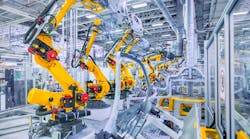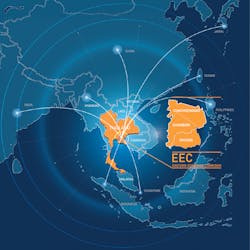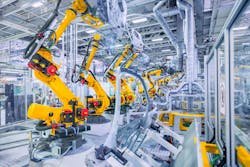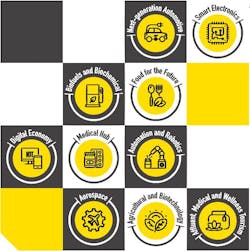Around the world, manufacturing plays a crucial role in promoting economic development and building successful communities. Machine Design recently spoke with Chokedee Kaewsang, deputy secretary general of Thailand’s Board of Investment, about manufacturing’s growth in Southeast Asia. What follows is taken from that interview.
Thailand is at the heart of one of the world’s major manufacturing zones and the Association of Southeast Asian Nations (ASEAN), which is one of the fastest growing regions. As a regional business hub with a well-diversified economy, Thailand’s manufacturing sector remains a key driver of the economy, and the industries play a crucial role in driving growth in manufacturing. The country is also known for its global or regional production bases for automobiles, electronics, electrical appliances, and hard disk drives, among other products.
To sustain Thailand’s manufacturing growth, the current government announced a policy to transform it into a high-value, innovation-driven economy. The policy targets 10 industries:
- Next-generation automotive
- Smart electronics
- Affluent medical and wellness tourism
- Agriculture and biotechnology
- Food for the future
- Automation and robotics
- Aviation and logistics
- Biofuels and biochemicals
- Digital economy
- Medical hub
Key Investment Incentives
One of the ways Thailand plans to continue growth in this area is to offer generous incentives for these targeted industries, including up to eight years of corporate income tax exemption; exemption of import duties on machinery; exemption of import duties on raw materials used in R&D; exemption of import duties on raw materials used in production for export; and other non-tax incentives.
Thailand’s Eastern Economic Corridor (EEC) is aimed to be the key economic driver to transform the country into a high-value and innovation-driven economy.
In case companies do more investment in any activities that enhance competitiveness including R&D, advanced technology training, IP licensing fees, product and package design, projects will be granted an additional corporate income tax exemption of up to three years.
Four Core Technologies for Promotion
- Biotechnology
- Nanotechnology
- Advanced material technology
- Digital technology
Thailand believes technologies such as these will enhance the country’s overall competitiveness. Projects in these four core technologies will be granted up to 10 years of corporate income tax exemption, and up to 13 years in case they are located in a special zone—the so-called “Eastern Economic Corridor,” or EEC. In addition, the projects must be engaged in technology transfer by cooperating with educational/research institutions, as stipulated by the Board (e.g., the Technology Research Consortium).
Thailand’s manufacturing sector plays a crucial role in its overall economy.
Consistent government support. In promoting manufacturing capabilities, the Board of Investment (BOI) recognizes the importance of the automations and robotics sector. It offers attractive incentives to the manufacture of robotics, equipment, and parts, and also provides continuous support to develop those industries, which are also identified as targeted industries. Thailand encourages company to invest for research and development and human resources training through cooperation with educational institutes such as the Institute of Field Robotics (FIBO), King Mongkut’s University of Technology, and Thonburi.
Thailand has already played an important role in world manufacturing industry. If you thought it was just a great place to vacation, check out its global rankings:
- In 2016, Thailand ranked 14th on the Global Manufacturing Competitiveness Index1 by Deloitte Touche Tohmatsu Limited and the U.S. Council, and is projected to rank the top 15 in 2020.
- Thailand ranked the sixth largest commercial vehicle manufacturer in the World in 2016.2
- Thailand is a growing robotics market in Asia, ranked eighth in the Global Supply of Industrial Robots in 2015.3
- Thailand was ranked the second largest global producer and exporter of hard disk drives (HDD).4
- Thailand’s machinery industry has seen substantial growth in recent years. According to the Machinery Intelligence Unit,5 in 2016, exports of machinery and parts reached $7.7 billion. The largest sector was industrial machinery with an export value of 77%, followed by agricultural machinery at 13% and machine tools at 10%.
- Strong business climate. Thailand was ranked the 26th most business-friendly nation in the 2018 according to the World Bank’s Ease of Doing Business. Thailand was the second-most improved country among 190 economies in the 2018 rankings, climbing from 46th in 2017.
This success has given Thailand a strong economy. In addition, Thailand is strategically located at the heart of Asia, one of the fastest growing regions with proximity to markets with over 600 million consumers. Acting as a gateway to ASEAN, with convenient routes throughout the country and accessible to all nearby countries. Thailand has considerable potential to be a manufacturing hub and to serve the large and growing market demand in neighboring countries, collectively dubbed CLMV (Cambodia, Laos, Myanmar, and Vietnam).
Fighting the Skills Gap
One of the biggest problems in industry today is the ability to find skilled employees that can grow a company. Many of these skills are in the science, technology, education, and mathematics (STEM) fields. This has led to some countries to call out to skilled workers around the world for help. Promising to streamline visas, pay for moving expenses, and other benefits.
Thailand already offers a large pool of qualified and affordable workers. With 76 universities and 83 vocational schools, Thailand produced approximately 56,231 graduates from engineering and related courses in 2016.
Thailand’s 10 S-Curve industries are the new engines of growth to move the country towards Thailand 4.0 goal.
Still, Thailand aims to attract highly-skilled foreign specialists in the area of science and technology by offering a long-term visa: the SMART Visa. The country also encourages the private sector to invest in human resource development by offering investment promotion measures that require cooperation with educational institutes.
The country has ambitious goals to transform itself into a high-value and innovation-driven economy and to become the region’s economic hub. To support such goals, the government has improved laws (e.g., the Investment Promotion Act and National Competitive Enhancement Act), infrastructure (through various large project investments), and the investment and business environment (e.g., investment incentives and promotions)
Another significant move involves the development of the Eastern Economic Corridor (EEC), which will attract more investment in the targeted industries and drive the economic transformation of the country. In 2018, Thailand’s target investment application value in the EEC is expected to be approximately $9.6 billion. In addition, the government has committed to continuously improving the investment ecosystem and environment to facilitate investment and increase Thailand’s overall international competitiveness rankings.
With all the investment incentive schemes, clear identification of targeted industries, and plans to promote human resources and skill development, Thailand is heading toward its goal of becoming a value-based economy driven by strong manufacturing industry. And, under this transformation process, a lot of opportunities are presented for investors.
References
- Deloitte, https://www2.deloitte.com/global/en/pages/manufacturing/articles/global-manufacturing-competitiveness-index.html
- Thailand Automotive Institute. 2016
- World Robotics 2016
- Ministry of Commerce, Electrical and Electronics Institute
- http://miu.isit.or.th/box/Download/193/Machinery%20Outlook_Year%202016.pdf and http://www.boi.go.th/upload/content/TIR_June2017_18344.pdf




